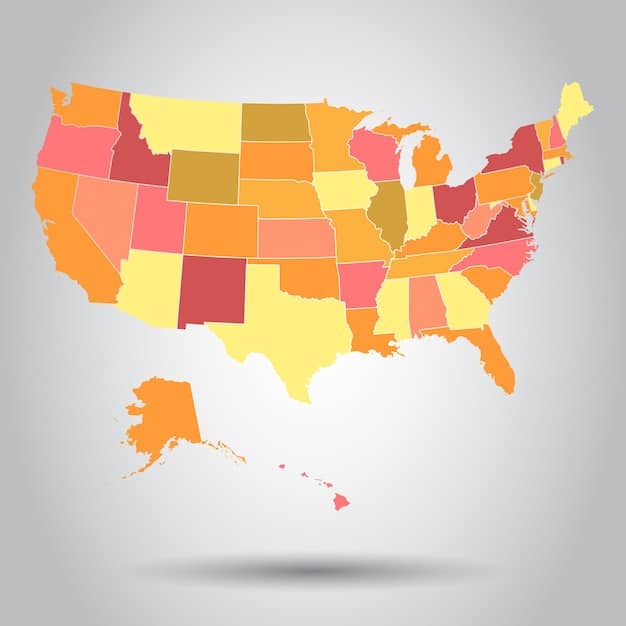National Weather Service Issues Severe Weather Alert: Safety Tips

Anúncios
The National Weather Service has issued a severe weather alert for multiple states, urging residents to prepare for potential hazards such as tornadoes, flash floods, and severe thunderstorms by staying informed and taking necessary safety precautions.
The National Weather Service Issues Severe Weather Alert for Multiple States: Prepare Now is not just a headline; it’s a call to action. This isn’t just another weather update; it’s about ensuring your safety and the safety of your loved ones when facing potentially life-threatening conditions.
Anúncios
Understanding the National Weather Service Alert System
When the National Weather Service (NWS) issues a severe weather alert, it’s crucial to understand what it means and how to respond. The NWS uses a tiered system to communicate the severity and potential impact of weather events, ensuring that the public and emergency responders have the information they need to make informed decisions.
Types of Weather Alerts
The NWS issues various types of alerts, each indicating a different level of threat. Understanding these distinctions is key to preparing effectively. Here are some of the most common alerts:
Anúncios
- Watch: A watch means that conditions are favorable for severe weather to develop in the specified area. It’s a signal to be vigilant and monitor weather updates.
- Warning: A warning indicates that severe weather is imminent or is already occurring. This requires immediate action to protect life and property.
- Advisory: An advisory is issued for less serious conditions that could still pose a hazard. For example, a heat advisory might be issued when high temperatures could cause heat-related illnesses.
Decoding the Alert Messages
NWS alerts contain specific information about the type of weather event, affected locations, and the expected timeframe. Pay close attention to these details. It’s also helpful to know what jargon the NWS might use:
- Hail Size: This will be included in severe thunderstorm warnings. Knowing the potential size of the hail helps you to assess the risks to your property.
- Wind Gusts: Expected peak wind speeds will be stated. Extreme winds can cause damage to structures and knock down trees.
- Flash Flood Threat: This warns of the risk of sudden, rapid flooding. It is critical to move to higher ground if you are in an area prone to flash floods.
Staying informed about the National Weather Service (NWS) alert system can equip you with the knowledge you need to make informed decisions during severe weather events. Understanding the types of alerts and how to decipher the messages ensures that you are prepared to take the necessary steps to protect yourself and your property.
States Under Threat: Identifying Impacted Regions
Pinpointing the states currently under a severe weather alert from the National Weather Service is crucial for residents to understand their risk level and take necessary precautions. Knowing which regions are in danger allows individuals to stay informed and prepare effectively.
Geographical Areas Affected
The specific states and regions under threat can vary with each weather system. Alerts often cover multiple states simultaneously, especially during widespread events like large storm systems or heatwaves. Keep in mind that even if your specific city or town isn’t mentioned, it’s essential to stay aware of conditions in neighboring areas.

How to Check if Your Area is at Risk
Staying updated on real-time weather alerts is simpler than ever, thanks to numerous online resources and tools. Here are some reliable methods to check if your area is under a severe weather alert:
- NWS Website: The National Weather Service’s official website (weather.gov) offers detailed maps and real-time updates. You can search by city, state, or zip code to find specific alerts.
- Local News Channels: Local television and radio stations provide up-to-the-minute weather reports, often with direct feeds from the NWS.
- Weather Apps: Numerous weather apps, such as The Weather Channel, AccuWeather, and local news apps, deliver alerts directly to your smartphone or tablet.
Additionally, sign up for emergency alert systems in your area. Many states and counties offer services that send alerts via text message or email, providing immediate notifications about severe weather threats. It’s essential to remain vigilant and monitor weather conditions regularly to stay one step ahead.
By staying informed about the geographical areas affected and utilizing the various resources available, residents can be well-prepared and take the necessary actions to protect themselves and their communities during severe weather events. Make sure your family and neighbors know how to stay informed too.
Preparing Your Home for Severe Weather
Preparing your home for severe weather involves implementing several crucial steps to minimize damage and ensure your family’s safety. Taking proactive measures can significantly reduce the impact of storms, floods, and other weather-related emergencies.
Securing Outdoor Items
One of the first and most effective steps in preparing your home is to secure outdoor items that could become projectiles in strong winds. This includes patio furniture, trash cans, garden tools, and decorative items. Store these items inside your garage, shed, or basement, or secure them tightly in place. Trim trees and shrubs around your home. Overhanging branches can break off during storms and cause damage to your roof, windows, or power lines.
Reinforcing Windows and Doors
Windows and doors are among the most vulnerable parts of your home during severe weather. Reinforce them to protect against flying debris and strong winds. Here are some ways to reinforce your windows and doors:
- Install Storm Shutters: Storm shutters provide a solid barrier against wind and debris. These can be permanent fixtures or temporary panels that you install before a storm.
- Apply Reinforcement Film: Window film can make glass more resistant to shattering. While it won’t prevent breakage, it can hold the glass together, reducing the risk of injury and water damage.
- Strengthen Doors: Ensure that your exterior doors are solid and have strong frames. Replace hollow-core doors with solid-core doors and reinforce door frames with metal strike plates.
Creating an Emergency Kit
Creating an emergency kit is an essential aspect of preparing your home for severe weather. This kit should include enough supplies to sustain your family for at least 72 hours. Essential items to include in your emergency kit:
- Water: At least one gallon of water per person per day.
- Food: Non-perishable items such as canned goods, energy bars, and dried fruit.
- First Aid Kit: Include bandages, antiseptic wipes, pain relievers, and any prescription medications.
- Flashlight and Batteries: Essential for navigating during power outages.
By taking these steps to prepare your home, you can significantly reduce the risk of damage and ensure your family’s safety during severe weather events. Regular maintenance and proactive measures will make your home more resilient and provide peace of mind when storms threaten.

Developing a Family Emergency Plan
Developing a family emergency plan is crucial for ensuring the safety and well-being of your loved ones during severe weather events. A well-thought-out plan provides a clear roadmap for how to respond in different emergency situations, reducing confusion and panic.
Establishing Communication Protocols
One of the first steps in developing a family emergency plan is to establish clear communication protocols. During severe weather, normal communication channels may be disrupted, making it difficult to reach family members. Establish a central meeting point where family members can gather. This could be a neighbor’s house, a community center, or any safe location known to all family members.
Designating Escape Routes and Shelters
Identifying escape routes and shelters is another critical element of your family emergency plan. Different types of severe weather may require different responses, so it’s essential to plan for various scenarios. Safe room: Designate a safe room or interior space in your home where family members can take shelter during a tornado or other high-wind event. This should be a room on the lowest level of your home, away from windows and exterior walls.
Practicing the Plan
A plan is only effective if it is well-understood and practiced regularly. Conduct drills with your family to ensure everyone knows what to do in different emergency scenarios. Practice evacuation routes, communication protocols, and shelter procedures. Make it a habit to review and update your emergency plan at least twice a year. Weather patterns and family circumstances change, so it’s essential to keep your plan current. Discuss any new threats or vulnerabilities and adjust the plan accordingly.
By developing a thorough family emergency plan and practicing it regularly, you can significantly enhance your family’s ability to respond effectively during severe weather events. A well-prepared family is a resilient family, ready to face whatever challenges may come their way.
Staying Informed: Reliable Weather Resources
Staying informed during severe weather is paramount for making timely decisions and ensuring personal safety. Access to reliable weather resources can provide up-to-the-minute information, helping you stay ahead of potential threats.
Official Government Sources
Government agencies are primary sources for accurate and timely weather information. The National Weather Service (NWS) is the leading authority on weather forecasts and alerts. Its local offices provide detailed information specific to your area. The NWS website (weather.gov) is a comprehensive resource offering real-time weather maps, forecasts, and alerts. You can search by location to find detailed information about your area.
- National Oceanic and Atmospheric Administration (NOAA): NOAA provides a wealth of scientific data and information about weather, oceans, and the atmosphere.
- Federal Emergency Management Agency (FEMA): FEMA offers resources and guidance on preparing for and responding to disasters, including severe weather events.
Utilizing Weather Apps and Websites
Weather apps and websites provide convenient and accessible weather information right at your fingertips. Many apps offer customizable alerts, radar maps, and detailed forecasts. Popular choices include The Weather Channel, AccuWeather, and local news apps. Choose apps and websites that provide data from reliable sources, and that offer customizable alerts so that you can get notified about specific types of severe weather in your area.
Following Local News and Media
Local news and media outlets are valuable sources of weather information. They provide coverage tailored to your specific area, often featuring local meteorologists who understand regional weather patterns. Local news channels are a traditional source of weather updates. Tune in to your local TV or radio station for forecasts, alerts, and live coverage of severe weather events.
By utilizing a combination of official government sources, weather apps and websites, and local news and media, you can stay well-informed and make informed decisions during severe weather events. Staying connected to these resources ensures you have the latest information to protect yourself and your community.
Recovering After the Storm: Post-Weather Safety
Recovering after a severe weather event requires a careful approach to safety and damage assessment. Once the storm has passed, it is essential to take specific steps to protect yourself and your property from further harm.
Assessing Property Damage
Begin with a thorough assessment of your property. Look for structural damage to your home, including cracks in walls, a sagging roof, or leaning structures. Exercise caution when inspecting your home, as weakened structures could collapse. Take photos and videos of the damage for insurance purposes. Document everything in detail, including the date, time, and extent of the damage.
Avoiding Downed Power Lines
Electricity poses a significant risk after a severe storm. Downed power lines can energize the ground and surrounding objects, creating a deadly hazard. Stay at least 30 feet away from downed power lines. Report any downed power lines to your local utility company immediately. Do not attempt to touch or move them yourself.
Dealing with Flooding
Flooding can leave behind contaminated water and structural damage, requiring specific precautions. Wait for the water to recede before entering flooded areas. Wear protective clothing. Wear waterproof boots, gloves, and eye protection to minimize contact with contaminated water. Disinfect flooded areas and items. Use a solution of bleach and water to disinfect surfaces and prevent mold growth.
By following these post-weather guidelines, you can minimize the risk of injury, prevent further damage, and begin the process of recovery safely and effectively. Taking a measured and cautious approach is key to navigating the aftermath of severe weather.
| Key Point | Brief Description |
|---|---|
| ⚠️ NWS Alerts | Understand watches, warnings, and advisories for timely action. |
| 🏠 Home Prep | Secure outdoor items and reinforce windows to minimize damage. |
| 👨👩👧👦 Family Plan | Establish meeting points and communication for emergencies. |
| ⚡ Power Lines | Stay away from downed power lines and report immediately. |
Frequently Asked Questions (FAQ)
▼
A severe weather “watch” means that conditions are favorable for severe weather to develop in the area. It’s a signal to be vigilant and monitor weather updates closely.
▼
You can protect your windows by installing storm shutters or applying reinforcement film. These measures can help prevent damage from strong winds and flying debris.
▼
An emergency kit should include water, non-perishable food, a first aid kit, a flashlight, batteries, and any necessary medications to sustain you for at least 72 hours.
▼
If you see a downed power line, stay at least 30 feet away from it and report it to your local utility company immediately. Do not attempt to touch or move it yourself.
▼
You should review and update your family emergency plan at least twice a year. Weather patterns and family circumstances can change, so keep the plan current.
Conclusion
In conclusion, being proactive and well-informed is crucial when the National Weather Service Issues Severe Weather Alert for Multiple States: Prepare Now. By understanding the alert system, preparing your home, developing a family emergency plan, and staying connected to reliable weather resources, you can significantly enhance your safety and resilience during severe weather events. Take the necessary steps to protect yourself, your loved ones, and your community when the next alert sounds.





